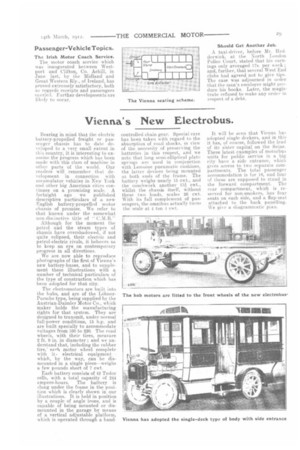Vienna' s New Electrobus.
Page 9

If you've noticed an error in this article please click here to report it so we can fix it.
Bearing in mind that the electric battery-propelled freight or passenger chassis has to date developed to a very small extent in this country, it is interesting to examine the progress which has been made with this class of machine in oiler parts of the world. Our readers will remember that development in connection with accumulator vehicles in New York and other big American cities continues on a promising scale. A fortnight ago we published descriptive particulars of a new English battery-propelled motor chassis of promise. We refer to that known under the somewhat non-distinctive title of " Although for the moment the petrol and the steam types of chassis have overshadowed, if not quite eclipsed, their electric and petrol-electric rivals, it behoves us to keep an eye on contemporary progress in all directions.
We are now able to reproduce photographs of the first of Vienna's new battery-buses, and to supplement these illustrations with a number of technical particulars of the type of construction which has been adopted for that city.
The electromotors are built into the hubs, and are of the LohnerPorsche type, being supplied by the Austrian-Daimler Motor Co., which maker holds the manufacturing rights for that system. They are designed to transmit, under normal full-power conditions, 15 h.p. and are built specially to accommodate voltages from 160 to 220. The road wheels, with their tires, measure 2 ft. 9 in. in diameter ; and we understand that, including the rubber tire,' eaett motor wheel complete with it-electrical equipment which, by the way, can he dismounted in a single piece—weighs a few pounds short of 7 cwt.
Each battery consists of 42 Tudor cells, with a total capacity of 244 ampere-hours. The battery is slung under the frame in the position which is clearly shown in our illustrations. It is held in position by a couple of angle irons, and is capable of being mounted or dismounted in the garage by means of a vertical adjustable platform, which is operated through a hand
controlled chain gear. Special care has been taken with regard to the absorption of road shocks, in view of the necessity of preserving the batteries in this respect, and we note that long semi-elliptical plate springs are used in conjunction with Lemoine pneumatic cushions, the latter devices being mounted at both ends of the frame. The battery weighs nearly 15 cwt., and the coa.chwork another 1.:q cwt., whilst the chassis itself, without these two loads, scales 26 cwt. With its full complement. of passengers, the omnibus actually turns the scale at 4 ton 4 cwt.
It will be seen that Vienna has adopted single deckers, and in this it has, of course, followed the lead of its sister capital on the Seine. These latest examples of motorbus units for public service in a big city have a side entrance, which gives access to two separate compartments. The total passenger accommodation is for 18, and four or these are supposed to stand in the forward compartment. The rear compartment, which is reserved for non-smokers, has four seats on each side, and a flap-seat attached to the back panelling. We give a diagrammatic pian.
























